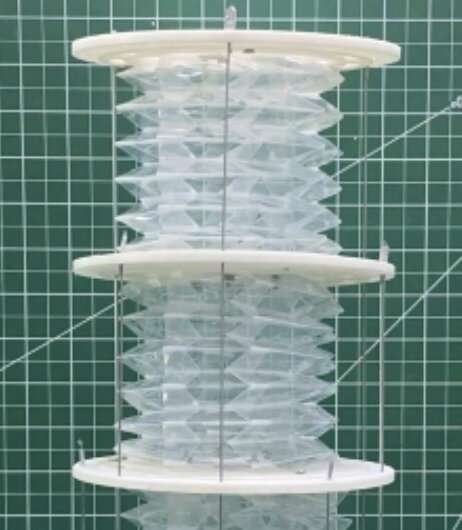June 9, 2023 feature
This article has been reviewed according to Science X's editorial process and policies. Editors have highlighted the following attributes while ensuring the content's credibility:
fact-checked
trusted source
proofread
Team creates modular continuous robot based on origami-folded tubes

In recent years, roboticists have created a growing number of autonomous systems based on different structures and designs. Among these are modular robots, which are composed of different elements or "modules" that can be reconfigured to carry out specific tasks more effectively.
Origami, the Asian art of folding paper to create 3D decorative shapes, can be a valuable inspiration for the creation of modular robotic structures. This is because it offers predefined models and patterns through which 2D sheets of materials can be turned into elaborate 3D structures with different mechanical properties.
Researchers at Guangzhou University, Yanshan University, and other universities in China recently created a new modular continuous robot constructed of a series of tubes based on a specific origami fold, known as the Miura fold. This robot, introduced in a pre-print paper published on SSRN, can contract and bend following specific patterns to complete different tasks.
"Folding a flat sheet under a specific crease pattern may form a three-dimensional origami tube, which has been proven to exhibit unique mechanical properties and has wide engineering applications," Junfeng He, Guilin Wen and their colleagues told Tech Xplore. "In this study, a Miura-derived origami tube is designed and its precise circular closing condition and mechanical properties are analyzed, revealing that the origami tube has programmable stiffness characteristics."
The Miura fold is an origami pattern that results in the folding of a flat surface into a structure with a smaller area. This fold has been used to create different technologies that may benefit from this change in shape, including large solar panels for satellites, which can be launched while folded on themselves and then spread out in space.
As part of their study, He, Wen and their colleagues used this fold to create flexible tubes, which then served as the basis of their robot. These tubes are based on a sheet of polyvinyl chloride (PVC), a robust material sometimes used to create medical devices, pipes, and insulations for cables.
This material has several advantageous characteristics, including flexibility and a high resistance when bent or compressed. As a result, the tubes that serve as the backbone of the modular robot are flexible and can be bent, compressed, and twisted without breaking.
To assess the viability of their design and the robustness of the origami structures it is based on, the researchers created a prototype robot made of three flexible tube modules. This robot can both fold on itself to reduce its size and bend to the side.
"Three separate steel wires drive each module to achieve independent contraction or bending movement," He, Wen and their colleagues explained in their paper. "The unified installation of steel wire-driven motors on the base endows the robot with a lightweight, interconnected inner space, high scalability, and [a flexible] backbone."
He, Wen and their colleagues evaluated their prototype in a series of experiments and found that it could successfully complete two different tasks. The first consists of docking onto its base when in a narrow space, and the second, requiring the installation of a magnetic gripper at the top of its structure, entails holding and lifting objects.
In the future, this new modular, origami-based design could be used to create other robots that can effectively tackle different real-world problems. In addition, this team's work could inspire the creation of other origami-based flexible structures that could serve as the backbone of other robotic systems.
More information: Junfeng He et al, A Modular Continuous Robot Constructed by Miura-Derived Origami Tubes, SSRN (2023). DOI: 10.2139/ssrn.4455959
© 2023 Science X Network



















